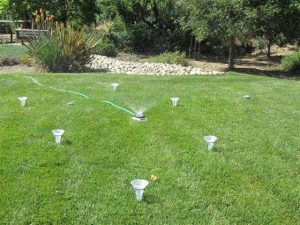The Water Conservation Act of 2009, also referred to as SB (Senate Bill) x7-7,
or “20 by 2020,” mandates that California will reduce urban per capita water use by 20% by the year 2020. It also requires all water suppliers to increase water use efficiency.
The text of the bill can be found at http://www.water.ca.gov/wateruseefficiency/sb7/.
It’s estimated that 50% of California’s residential water is used outdoors-to
water lawns, ornamental plantings, and vegetable gardens and in swimming pools. Our water use practices can always become more efficient.
To help us become more aware of our watering practices, July is designated
as Smart Irrigation Month by the national Irrigation Association. July is the month across most of North America when evapotranspiration rates are highest. The Irrigation Association uses the phrase “saved water is money in the bank” to draw attention to the need to water our landscapes and gardens, our golf courses and shopping center plantings more efficiently.
In a presentation in Groveland, California, Brad Lancaster, the author
of “Rainwater Harvesting for Drylands and Beyond,” asked the question, “Why do we use treated drinking water to irrigate our lawns?” The number one use of energy in California is to pump and move water. Any water we save on our landscapes is definitely money in the bank!
Many of us in Cooperative Extension outreach hear the same question over and
over during our hot, inland California summers, “How much should I water?” Although there are rough and simple rules of thumb, the answer is, “It depends.” Effective irrigation depends on several factors – type of soil, slope, elevation, type of plants, where the plant is growing, etc.
The University of California Integrated Pest Management (IPM) website offers
in-depth information for California residents interested in healthy lawn care and efficient irrigation. If you aren’t familiar with the website, please check out the interactive irrigation testing and scheduling tools at http://www.ipm.ucdavis.edu/TOOLS/TURF/MAINTAIN/index.html
In addition to efficient irrigation scheduling, there are some fairly simple (and
some not-so-simple) techniques that can help reduce outdoor residential water use:
- Check watering depth. A long screwdriver blade will penetrate easily into damp soil. Use it to gauge how deeply water is penetrating.
- Add organic material to the soil. Compost, home-made or purchased, helps clay soils drain and helps sandy soils retain moisture. Compost also reduces water demands, helps controls soil erosion and reduces plant stress from drought.
- To combat evaporation, plant closely enough that plants shade the soil.
- Mulch, mulch, mulch to slow evaporation from the soil surface.
- The amount of water needed varies by species of plant, the time of year, the amount of sunlight, air temperature, and other similar factors. The general rule of thumb is that turf grasses use about a quarter inch of water per day during the hottest part of the summer. To replace that two inches of water per week, apply an inch of water every four days during the peak heat season.
- Consider replacing some plantings with drought-tolerant natives.
- Consider reducing lawn size.
- Check sprinklers for leaks, broken heads, misaligned spray patterns and run-off.
- If water is running off, “cycle” irrigation by running sprinklers until run-off appears, stop until water infiltrates, and repeat until deep irrigation is achieved.
Go to www.ipm.ucdavis.edu and click on “UC Guide to Healthy Lawns” to learn
Rebecca Miller-Cripps is a Tuolumne County master gardener and UC Cooperative Extension Natural Resources program staff member.


